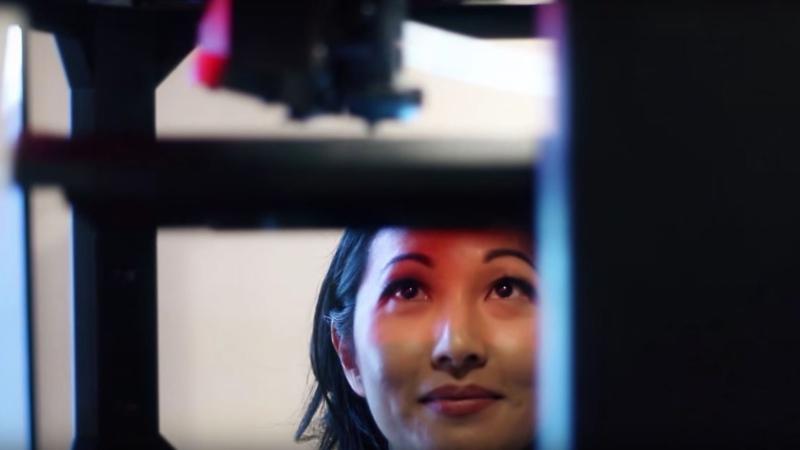Astronauts Aboard the ISS Will 3D Print Medical Tools in Space for the First Time, Thanks to Dr. Wong and 3D4MD
 3D printing made history back in 2014 when the first 3D printer in space, the Made In Space Zero-G 3D printer, was sent up to the International Space Station. One of the people cheering loudest for this major accomplishment was Toronto doctor Julielynn Wong, a friend of the founders of Made In Space, and the founder herself of 3D4MD, a company we’ve written about before that uses 3D printing and low-cost technologies to supply remote locations, including outer space, with healthcare supplies. Dr. Wong says Made In Space invited her to conduct some research on board the NASA aircraft known as the “vomit comet,” which is used to introduce aspiring astronauts to zero-gravity spaceflight.
3D printing made history back in 2014 when the first 3D printer in space, the Made In Space Zero-G 3D printer, was sent up to the International Space Station. One of the people cheering loudest for this major accomplishment was Toronto doctor Julielynn Wong, a friend of the founders of Made In Space, and the founder herself of 3D4MD, a company we’ve written about before that uses 3D printing and low-cost technologies to supply remote locations, including outer space, with healthcare supplies. Dr. Wong says Made In Space invited her to conduct some research on board the NASA aircraft known as the “vomit comet,” which is used to introduce aspiring astronauts to zero-gravity spaceflight.
During her testing, she met several NASA doctors and told them that it could eventually be possible to 3D print medical tools in space, and was soon after asked to test her theory at a Mars simulation habitat called the Mars Desert Research Station, where she was the first to 3D print medical supplies at the facility. The rest, as they say, is history: Dr. Wong has been hard at work making her theory a reality, and later this month, NASA astronauts will use a 3D printer on the ISS to create medical tools in space.
Dr. Wong joined three other female scientists last year in a simulated mission at NASA’s Johnson Space Center, to commemorate the 30th anniversary of the tragic Challenger explosion. After that project ended, she began her 3D printed medical tools experiment. Illness in space could spell disaster for a mission: as it currently stands, if an astronaut on the ISS needs a medical tool, like a surgical instrument or finger splint, they have to wait for a resupply mission to bring it to them. But that will soon be a thing of the past, as astronauts aboard the ISS will create 3D printed medical tools in space for the first time.
Dr. Wong explained, “We could take a laser scan stored from the fitting process for space suit gloves, use free software to create a digital model of a custom-fitted finger splint, uplink that digital file to the space station and 3D print it in space.”
One of the other tools Dr. Wong and the team at 3D4MD can 3D print that would be very helpful on the ISS is a three-in-one dental tool: it is a sensory evaluation tool that can be used to assess an injured astronaut, but can also be used as a surgical tool and to replace an astronaut’s filling. She told CTV News that she has always been interested in the concept of a replicator, and says it’s almost like having a 3D photocopier.
“Now, this month, we’ll be making medical history by 3D printing the first medical tools in space,” she said.
This concept has potential other applications than just space exploration: 3D printing as a means of creating medical tools can also have practical applications right here on Earth. Dr. Wong explained that “designing items for the ISS is similar to designing them for remote communities that are off the grid.” Healthcare workers in remote communities could potentially use cell phones and other handheld devices to 3D scan patients, and, with the help of solar-powered 3D printers, could create their own medical supplies, like custom-fitted splints.
“This will not only save time and money for Canadian patients, but could benefit the 45 percent of the world’s population who live in rural areas and who lack access to medical care,” said Dr. Wong.
She started 3D4MD in 2011, as a way to ensure that open source 3D printable medical files and models online are safe and work as they are supposed to, by creating her own files.
“I believe the 3D printer will become the doctor’s bag of the future,” she said.
She says the company is working on creating a digital library, where users could pick and download available, crowd-sourced 3D printable files, sort of like choosing a song on iTunes, in order to make on demand, lower-cost, patient-specific medical supplies.
Learn more in the video below:
Discuss in the 3D Printed Medical Supplies forum at 3DPB.com.
[Source: CTV News]
Subscribe to Our Email Newsletter
Stay up-to-date on all the latest news from the 3D printing industry and receive information and offers from third party vendors.
You May Also Like
3D Printing Unpeeled: New Arkema Material for HP, Saddle and Macro MEMS
A new Arkema material for MJF is said to reduce costs per part by up to 25% and have an 85% reusability ratio. HP 3D HR PA 12 S has been...
3D Printing News Briefs, January 20, 2024: FDM, LPBF, Underwater 3D Printer, Racing, & More
We’re starting off with a process certification in today’s 3D Printing News Briefs, and then moving on to research about solute trapping, laser powder bed fusion, and then moving on...
3D Printing Webinar and Event Roundup: December 3, 2023
We’ve got plenty of events and webinars coming up for you this week! Quickparts is having a Manufacturing Roadshow, America Makes is holding a Member Town Hall, Stratafest makes two...
Formnext 2023 Day Three: Slam Dunk
I’m high—high on trade show. I’ve met numerous new faces and reconnected with old friends, creating an absolutely wonderful atmosphere. The excitement is palpable over several emerging developments. The high...


































